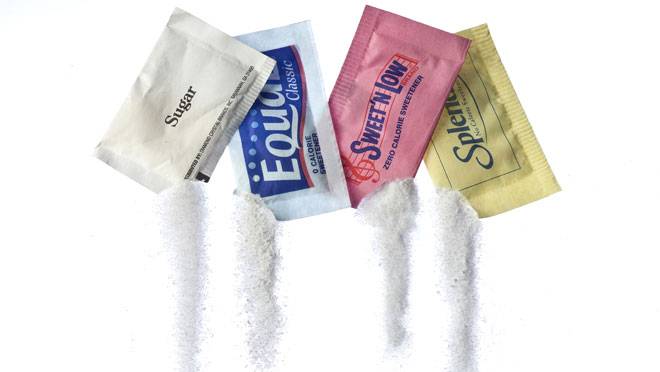By: Andreas Moritz
Book excerpt: Simple Steps to Total Health
As more and more people have become aware of the health hazards of sugar, there has been a tendency to look for sugar substitutes.
The most widely used artificial sweetener today is aspartame, known under trade names such as NutraSweet, Equal, Spoonful, Equal-Measure, Benevia and NatraTaste. Since the patent on it has now expired, it will undoubtedly show up on the market under a variety of new trade names.

The approval in the U.S. of aspartame for use in beverages and dry foods is one of the most disgraceful chapters of political influence, payoffs and corruption in the history of the Food and Drug Administration (FDA). As a member of the National Soft Drink Association, the Coca-Cola Company opposed FDA approval of aspartame for beverages. Their objections, running to several pages published in the Congressional Record of May 7, 1985, said aspartame is uniquely and inherently unstable and breaks down in the can. It decomposes into formaldehyde, methyl alcohol, formic acid, diketopiperazine and other toxins. In a study on 7 monkeys, 5 had severe seizures and one died – a casualty rate of 86%. In spite of this testimony, after aspartame was approved by the FDA, the Coca-Cola Company introduced Diet Coke, which is laden with aspartame. The story has all too many familiar parallels with the tobacco companies that, in spite of their full knowledge of the severe health risks of smoking, continue to manufacture and promote the use of cigarettes.
The European Common Market has at least banned aspartame for use in all children’s products.
Aspartame contains three primary ingredients:
50% Phenylalanine
40% Aspartic acid
10% Methanol (wood alcohol)
Let’s start with methanol. When a beverage containing aspartame is ingested, the methanol (wood alcohol) is distributed widely throughout the body, including the brain, muscles, fat and nerve tissues. It then metabolizes to formaldehyde, which enters the cells and binds to the proteins and DNA. Cytogenetic effects (changes in and injuries to the DNA) have been shown to result from formaldehyde. The nature of the injury involves breaking and then cross-linking within genetic materials which alters the cells. The ability of aspartame to cause such cellular mutations has been shown in studies. Increases in malignant brain tumors are suggested to be associated with aspartame use.
Next, let’s consider the effects of aspartic acid. It significantly raises the blood plasma level of aspartate and glutamate. Too much aspartate and glutamate in the brain kills certain neurons by allowing the influx of too much calcium into the cells. This influx triggers excessive amounts of free radicals, which kill the cells. The neural cell damage that can be caused by excessive aspartate and glutamate is why they are referred to as “excitotoxins.” They “excite” or stimulate the neural cells to death.
Phenylalanine is the third component of aspartame. It is an amino acid normally found in the brain. People with the genetic disorder, phenylketonuria, cannot metabolize phenylalanine. This leads to dangerously high levels of phenylalanine in the brain (sometimes lethal). It has been shown that ingesting aspartame, especially along with carbohydrates, can lead to excessive levels of phenylalanine in the brain, even in people who do not have phenylketonuria. Excessive levels of phenylalanine in the brain can cause serotonin levels in the brain to decrease, leading to emotional disorders such as depression. Even a single use of aspartame raises the blood’s phenylalanine levels. In his testimony before the U.S. Congress November 3, 1987, Dr. Louis J. Elsas explained that high blood phenylalanine can be concentrated in parts of the brain, and is especially dangerous for infants and fetuses.
Watch Dr. Mercola Speak about The Dangers and Side Effects of Aspartame
[Video removed from YouTube] [Video removed from YouTube] [Video removed from YouTube]
Six Healthy Alternative & Natural Sweeteners
A bit of sweetness is not out of place in a healthy diet so long as it is in balance with other foods. There are several natural sweeteners that have few, if any, harmful side effects. However, just as sweet fruits and fruit juices need to be consumed in moderation, and in appropriate relationship to other types of foods, the same is true of the following natural sweeteners. Most “natural” sweeteners are certainly preferable to refined sugar or chemical sweeteners.
1) Honey is the oldest known natural sweetener, with references to it dating back virtually as far as recorded history. As we know, it is produced by bees from the nectar they collect from the blossoms of plants and trees. The color, flavor and scent of a particular honey is determined by the nectar of the flower from which it was collected, as well as the soil, its location, and the time of the year in which it was collected. In commercial bee-keeping operations, beehives are typically placed in close proximity to a natural source of nectar, such as a clover field or orange grove. The qualities of such honey are then predominately related to the clover or orange blossoms, but all honey is a blend of the nectar of various blossoms as bees follow their instincts in the gathering process. The general rule of thumb is that the darker the honey, the more intense its flavor.
2) Xylitol – In spite of its ominous-sounding name, Xylitol is a natural carbohydrate that is found in fibrous plants and vegetables, including birch and other hardwood trees, berries, almond hulls and corncobs. It has been approved for use as a sugar substitute in over 35 countries. Xylitol is a sugar alternative that looks and tastes like real sugar, but contains less than 40% of the calories. The human body produces small amounts (5-15 grams per day) during normal metabolism. In contrast to ordinary sugar, Xylitol does not encourage growth of yeast, including candida albicans. Xylitol also increases the absorption of B-vitamins and calcium.
3) Stevia is an herb, native to Paraguay, that has been used as a sweetener and flavor enhancer for centuries. The Guarani Indians had known about the unique advantages of this plant long before the arrival of the Spanish invaders. Prior to 1900, stevia had grown only in the wild, and consumption was limited to those having access to its natural habitat. With the gradual introduction of stevia as a commercial crop, it eventually began to attract attention throughout Latin America and beyond.
4) Date sugar is a powder made by grinding up dried dates, so it enjoys the same health benefits as dates. However, date sugar does not dissolve well in liquids.
5) Pure maple syrup is made from the sap of sugar maple trees. Although it has a wonderful flavor, the boiling process used to thicken it damages many of its natural nutrients.
6) Agave syrup is made from the agave (uh-gah-vay) plant which has long been cultivated in hilly, semi-arid soils of Mexico. Its fleshy leaves cover the pineapple-shaped heart of the plant, which contains a delicious, sweet sticky juice, made of 90% fructose.
This is an excerpt from Andreas Moritz‘s book Simple Steps to Total Health.
You may share or republish this article provided you clearly mention the name of Andreas Moritz and paste a hyper link back to the post:
https://www.ener-chi.com/6-healthier-alternatives-to-aspartame/





